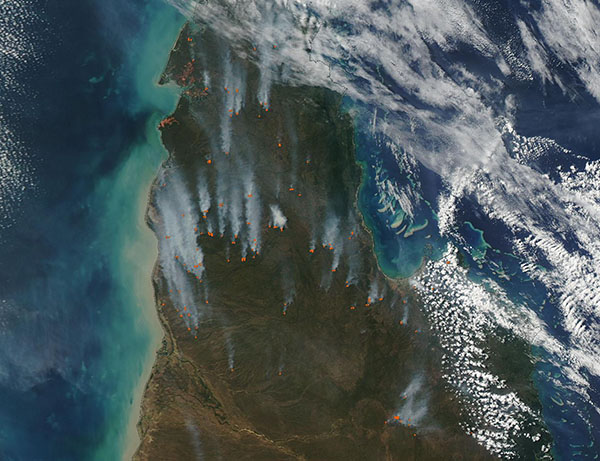Images
July 26, 2024 - Fires in Queensland, Australia
Tweet
On July 17, 2024, the Moderate Resolution Imaging Spectroradiometer (MODIS) on NASA’s Aqua satellite acquired a dramatic true-color image of multiple fires burning across Cape York Peninsula in Queensland, Australia. Each active fire is marked by a red “hot spot”. Copious gray smoke rises from the fires and is blown northward by strong, steady winds.
Cape York Peninsula is globally significant as one of the last great Wet/Dry tropical systems in the world and is sometimes referred to as one of the largest unspoiled wilderness areas in the world, according to the Cape York National Resource Management website. While the ecosystem remains relatively intact, it still is home to people, agriculture, and is widely under management to retain a healthy ecosystem.
Bushfires can occur at any time of the year, but the fire season in Cape York typically starts in August and runs through December, during the driest time of the year. At that time, bushfires can roar across as much as seventy percent of the Cape, causing considerable damage. To try to avoid disastrous bushfires and to help keep the ecosystem and residents safe, prescribed burning is widely used across much of Australia, including Cape York Peninsula. These burns, also called Hazard Burns, are intentionally lit, managed, then doused when the desired burn has been completed. July is peak fire management season in this region, as the grasses are at peak growth but are not yet so dry as to easily feed out of control spread.
While it’s not possible to know the cause of a fire just by satellite imagery, it is likely that most of the fires visible in this image are prescribed burns, not wild bushfires. The Queensland Fire Department website lists many dozens of Hazard Burn Notifications as of July 25, with dates going back to mid-July.
Image Facts
Satellite:
Aqua
Date Acquired: 7/17/2024
Resolutions:
1km (64.2 KB), 500m (198.3 KB), 250m (554.1 KB)
Bands Used: 1,4,3
Image Credit:
MODIS Land Rapid Response Team, NASA GSFC
Tweet
On July 17, 2024, the Moderate Resolution Imaging Spectroradiometer (MODIS) on NASA’s Aqua satellite acquired a dramatic true-color image of multiple fires burning across Cape York Peninsula in Queensland, Australia. Each active fire is marked by a red “hot spot”. Copious gray smoke rises from the fires and is blown northward by strong, steady winds.
Cape York Peninsula is globally significant as one of the last great Wet/Dry tropical systems in the world and is sometimes referred to as one of the largest unspoiled wilderness areas in the world, according to the Cape York National Resource Management website. While the ecosystem remains relatively intact, it still is home to people, agriculture, and is widely under management to retain a healthy ecosystem.
Bushfires can occur at any time of the year, but the fire season in Cape York typically starts in August and runs through December, during the driest time of the year. At that time, bushfires can roar across as much as seventy percent of the Cape, causing considerable damage. To try to avoid disastrous bushfires and to help keep the ecosystem and residents safe, prescribed burning is widely used across much of Australia, including Cape York Peninsula. These burns, also called Hazard Burns, are intentionally lit, managed, then doused when the desired burn has been completed. July is peak fire management season in this region, as the grasses are at peak growth but are not yet so dry as to easily feed out of control spread.
While it’s not possible to know the cause of a fire just by satellite imagery, it is likely that most of the fires visible in this image are prescribed burns, not wild bushfires. The Queensland Fire Department website lists many dozens of Hazard Burn Notifications as of July 25, with dates going back to mid-July.
Image Facts
Satellite:
Aqua
Date Acquired: 7/17/2024
Resolutions:
1km (64.2 KB), 500m (198.3 KB), 250m (554.1 KB)
Bands Used: 1,4,3
Image Credit:
MODIS Land Rapid Response Team, NASA GSFC




